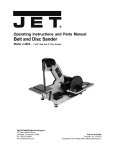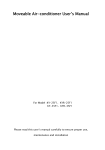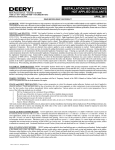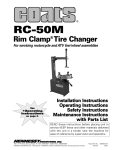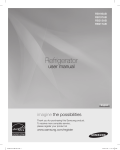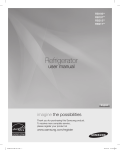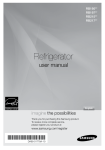Download Wilton 4002 Operating instructions
Transcript
Operating Instructions — Parts Manual 1-Inch Belt / 8-Inch Disc Sander Model 4002 Part No. 9078321 Revision A1 Table of Contents Cover .................................................................................................................................... 1 General specifications .......................................................................................................... 3 Machine general safety warning ........................................................................................... 4 Safe operation precautions ................................................................................................... 5 Setting up the sander ............................................................................................................ 6 Operating instructions ........................................................................................................... 9 Adjustments ........................................................................................................................ 10 Typical operations ............................................................................................................... 13 Replacement parts ............................................................................................................. 15 Belt Sander Parts - Exploded View ................................................................................. 16 Belt Sander Parts - Parts List .......................................................................................... 17 Disc Sander Parts - Exploded View ................................................................................. 18 Disc Sander Parts - Parts List ......................................................................................... 19 2 General Specifications The Wilton Model 4002 sander is designed to serve the varying sanding needs of the professional or the home hobbyist. The sander features both a belt and a disc sanding surface. Specifications Belt 1-inch wide x 42-inches long Disc 8-inches diameter Motor 1/3 horsepower, 1725 rpm Power requirements 115 volts Dimensions: Sander (LWH) 25.50 x 15.50 x 19.50 inches 3 WARNING - Misuse of this machine can cause serious injury. - For safety, machine must be set up, used and serviced properly. - Read, understand and follow instructions in the Operating Instructions and Parts Manual which was shipped with your machine. When setting up machine: - Always avoid using machine in damp or poorly lighted work areas. - Always be sure the machine support is securely anchored to the floor or the work bench. When using machine: - Always wear safety glasses with side shields (See ANSI Z87.1) - Never wear loose clothing or jewelry. - Never overreach - you may slip and fall. When servicing machine: - Always disconnect the machine from its electrical supply while servicing. - Always follow instructions in Operating Instructions and Parts Manual when changing accessory tools or parts. - Never modify the machine without consulting Wilton Corporation. You—the stationary power tool user— hold the key to safety. Read and follow these simple rules for best results and full benefits from your machine. Used properly, Wilton’s machinery is among the best in design and safety. However, any machine used improperly can be rendered inefficient and unsafe. It is absolutely mandatory that those who use our products be properly trained in how to use them correctly. They should read and understand the Operating Instructions and Parts Manual as well as all labels affixed to the machine. Failure in following all of these warnings can cause serious injuries. Machinery general safety warnings 4 1. Always wear protective eye wear when operating machinery. Eye wear shall be impact resistant, protective safety glasses with side shields which comply with ANSI Z87.1 specifications. Use of eye wear which does not comply with ANSI Z87.1 specifications could result in severe injury from breakage of eye protection. 2. Wear proper apparel. No loose clothing or jewelry which can get caught in moving parts. Rubber soled footwear is recommended for best footing. 3. Do not overreach. Failure to maintain proper working position can cause you to fall into the machine or cause your clothing to get caught pulling you into the machine. 4. Keep guards in place and in proper working order. Do not operate the machine with guards removed. 5. Avoid dangerous working environments. Do not use stationary machine tools in wet or damp locations. Keep work areas clean and well lit. 6. Avoid accidental starts by being sure the start switch is “OFF” before plugging in the machine. 7. Never leave the machine running while unattended. Machine shall be shut off whenever it is not in operation. 8. Disconnect electrical power before servicing. 9. 10. 11. 12. 13. 14. 15. 16. 17. Whenever changing accessories or general maintenance is done on the machine, electrical power to the machine must be disconnected before work is done. Maintain all machine tools with care. Follow all maintenance instructions for lubricating and the changing of accessories. No attempt shall be made to modify or have makeshift repairs done to the machine. This not only voids the warranty but also renders the machine unsafe. Machinery must be anchored to the floor. Secure work. Use clamps or a vise to hold work, when practical. It is safer than using your hands and it frees both hands to operate the machine. Never brush away chips while the machine is in operation. Keep work area clean. Cluttered areas invite accidents. Remove adjusting keys and wrenches before turning machine on. Use the right tool. Don’t force a tool or attachment to do a job it was not designed for. Use only recommended accessories and follow manufacturers instructions pertaining to them. Keep hands in sight and clear of all moving parts and cutting surfaces. 18. All visitors should be kept at a safe distance from the work area. Make workshop completely safe by using padlocks, master switches, or by removing starter keys. 19. Know the tool you are using its application, limitations, and potential hazards. General electrical cautions This sander should be grounded in accordance with the National Electrical Code and local codes and ordinances. This work should be done by a qualified electrician. The sander should be grounded to protect the user from electrical shock. WARNING: Do not connect the sander to a 240 volt power source. The sander motor requires 120 volts alternating current. Conductor length 0-50 feet 50-100 feet Over 100 feet Wire sizes Caution: For circuits which are far away from the electrical service box, the wire size must be increased in order to deliver ample voltage to the motor. To minimize power losses and to prevent motor overheating and burnout, the use of wire sizes for branch circuits or electrical extension cords according to the following table is recommended. AWG (American wire gauge) number 240 volt lines NOT APPLICABLE NOT APPLICABLE NOT APPLICABLE 120 volt lines No. 14 No. 12 No.8 Safety instructions for the 1-Inch belt / 8-Inch disc sander WARNING: Do not operate your machine until it is completely assembled and installed according to the instructions. WARNING: The dust generated by certain woods and wood products can be injurious to your health. Always operate machinery in well ventilated areas and provide for proper dust removal. Use wood dust collection systems whenever possible. WARNING: This machine can be use for processing wood or metal products. However, combining wood dust and metal filings can create a fire hazard. Make sure that the dust collector is free of wood dust deposits before processing metal products. 1. If you are not thoroughly familiar with the operation of belt and disc sanders, obtain advice from your supervisor, instructor or other qualified person. 2. If there is a tendency for the machine to tip over or move during operation such as when sanding long or heavy boards, the machine must be securely fastened to a supporting surface. 3. Make sure the sanding belt is running in the proper direction. The sanding belt must travel downward when viewed from the front of the machine. 4. Make sure the sanding belt is tracking correctly in order that it does not run off the pulleys. 5. Make sure the sanding belt or disc is not torn or loose. 6. Hold the work firmly when sanding. 7. Always hold the work firmly on the table when sanding on the belt or disc. The only exception is curved work performed on the top wheel of the belt. 8. Always sand on the downward side of the disc when using the disc portion of the machine, so that the work is held securely on the table. Sanding on the upward side of the disc could cause the workpiece to fly up which could be hazardous. 9. Always maintain a minimum clearance of 1/16inch or less between the table and the sanding belt or disc. 10. Never wear gloves or hold the work with a rag when sanding. 11. Sand with the grain of the wood. 12. Do not sand pieces of material that are too small to be safely supported. 13. Avoid awkward hand positions where a sudden slip could cause a hand to move into the sanding belt or disc. 14. When sanding a large workpiece, provide additional support at table height. 15. Never force the work. Slowing or stalling the motor will cause overheating. 16. When sanding metal, never use a steady stream of water on the work piece. Dip the workpiece in water to cool it. 5 17. Do not sand or polish magnesium. It could catch fire. 18. Always remove scrap pieces and other objects from the belt and disc tables before turning the machine ON. 19. Never perform layout, assembly or set-up work on the tables while the sander is operating. 20. Always turn the machine OFF and disconnect the cord from the power source before installing or removing accessories. 21. Never leave the machine work area when the power is ON or before the machine has come to a complete stop. Setting up the sander WARNING: For your own safety, do not connect the sander to the power source until the machine is completely assembled and you have read and understood the entire Operating Instructions and Parts Manual. Unpacking The sander is shipped complete in one carton. Carefully unpack the machine and all loose items from the carton. If any parts are missing, do not attempt to operate your sander until the missing parts are obtained and installed correctly. Cleaning Remove the protective coating from the surfaces of the sander and from any loose parts. This coating may be removed with a soft cloth moistened with kerosene (do not use acetone, gasoline or lacquer thinner for this purpose). After cleaning, cover the table surfaces with a good quality paste wax. Assembly Figure 1. Installing the disc sander table Assembly of the sander is limited to the installation of the disc table and the belt table. Proceed as described in the following paragraphs. Assembling sanding disc table 6 WARNING: When assembling the sanding disc table, make certain the motor is disconnected from the power source. 1. The sanding disc table is secured with two cap screws and nuts. A hex wrench is required to tighten the screws. 2. Set the table on the rounded pockets in the support casting. Install the nuts in the channel on the back side of the pockets. 3. Install the screws through the table and base casting into the nuts. Tighten the screws. 4. Check for 1/16-inch clearance between the edge of the table and the face of the disc. Adjust the clearance if required (see Removal/Installation of the Disc). Installing belt sander table WARNING: When assembling the belt sander table, make certain the motor is disconnected from the power source. 1. The belt table is secured with a spring-loaded locking handle assembly. The handle assembly is disassembled for ease of installation. Figure 2. Securing the disc sander table 2. Remove the screw and spring from the handle assembly. Separate the handle and stud. 3. Set the table in place against the sander. 4. Put the flat washer provided in the sander carton on the stud. 5. Install the stud through the belt table bracket and into the sander housing. Tighten the stud finger tight. 6. Install the handle over the stud. Install the spring and screw into the stud. 7. To tighten the handle (and secure the table), pull out on the handle. While holding the handle out, turn the handle counterclockwise. Release the handle and tighten in a clockwise direction. Repeat as required to secure the table. Figure 3. Installing stud in table bracket Setup Fastening sander to supporting surface During operation the sander may have a tendency to slide or move about on the bench or table. It is recommended that the sander be fastened to the bench or table. Two holes are supplied in the sander base plate for easy mounting. Dust chutes The sander has two 1-1/4 inch diameter dust chutes (see Figure 5). The disc sander chute is at the rear of the sander under the disc sander table. The belt sander chute is in the cover on the left side of the sander. The chutes can be connected to a vacuum system to collect dust particles during use. 7 Figure 4. Belt table installed and handle in place Figure 5. Dust chutes Connecting sander to power source The motor supplied with your sander is wired for operation at 115 Volts. IT MUST NEVER BE CONVERTED TO OPERATE AT 230 VOLTS ! Before connecting the motor cord to the power source, make certain the switch is in the OFF position and be sure that the electric current is of the same characteristics as stamped on the motor nameplate. Grounding instructions WARNING: The sander must be grounded while in use to protect the operator from electric shock. Make sure that the receptacle is properly grounded. If you are not sure the receptacle is grounded, have a certified electrician check for proper grounding • In the event of a malfunction or breakdown, grounding provides a path of least resistance for electric current to reduce the risk of electric shock. This tool is equipped with an electric cord having an equipment-grounding conductor and a grounding plug. The plug must be plugged into a matching outlet that is properly installed and grounded in accordance with all local codes and ordinances. • Do not modify the plug provided—if it will not fit have a new outlet installed by a qualified electrician. • Improper connection of the equipmentgrounding conductor can result in risk of electric shock. The conductor with insulation having an outer surface that is green with or without yellow stripes is the equipment ground- • • • • ing conductor. If repair or replacement of the electric cord or plug is necessary do not connect the equipment grounding conductor to a live terminal. Check with a qualified electrician or service personnel if the grounding instructions are not completely understood, or if in doubt as to whether the tool is properly grounded. Use only 3-wire extension cords that have 3-prong grounding type plugs and 3-hole receptacles that accept the plug, as shown in Figure 6. Repair or replace damaged or worn cord immediately. This tool is intended for use on a circuit that has an outlet and a plug that looks like the one shown in Figure 6. A temporary adapter, which looks like the adapter illustrated in Figure 7, may be used to connect this plug to a 2-pole receptacle, as shown in Figure 7, if a properly grounded outlet is not available. 8 Figure 6. Grounded plug in grounded receptacle Figure 7. Grounded adapter connection Operating instructions Starting and stopping sander The on/off switch (see Figure 8) is mounted in a switch box on the right side of the sander base. Move the switch to the forward (ON) position to start the sander. Move the switch to the rear (OFF) position to stop the sander. Locking switch in the OFF position We recommend that the switch be locked in the OFF position when the sander is not in use. The switch can be locked by pulling the switch locking tab out of the switch toggle (see Figure 9). The switch will not operate with the locking tab removed. If the switch toggle is removed when the sander is running, it can be turned OFF once, but it cannot be restarted without inserting the switch tab. Figure 8. ON/OFF switch Tracking the sanding belt The belt tracking adjustment is set at the factory so the belt runs true on the pulleys. However, if the belt tracks to one side of the pulleys, tracking can be adjusted by turning the tracking knob . Turning the knob clockwise moves the belt to the right when facing the sander. Turning the knob counterclockwise will move the belt to the left. AVOID TURNING THE KNOB TOO FAR. THE AMOUNT OF ADJUSTMENT REQUIRED IS USUALLY VERY SLIGHT ! Platen WARNING: When making adjustments, make sure the motor is disconnected from the power source. The platen (see Figure 11) is used to properly support the work when sanding. The platen is constructed of heavy steel to provide adequate support. The platen should be adjusted so it is almost touching the back of the sanding belt. Loosen the cap screw and adjust the platen to the desired position. Tighten the screw to secure the platen. The platen can be removed for operations such as stripping, contour sanding, polishing or other special operations. To remove the platen, remove the cap screw. Be sure to reinstall the platen before performing operations where support of the belt is required. Figure 10. Adjusting belt tracking Figure 9. Switch locking tab 9 Figure 11. Platen Belt table adjustments The belt sander table can be tilted or moved in or out to accommodate the operation being performed. Loosen the locking handle to change the position of the table. Move the table to the desired position and tighten the locking handle. NOTE: The lock handle is spring loaded. Reposition the handle by pulling out on the handle and turning the handle on the serrated locking stud. Release the handle and turn the locking handle to tighten or loosen the table. WARNING: To avoid trapping the work or fingers between the table and sanding belt, the table edge should be positioned a maximum of 1/16-inch from the sanding belt. Setting the belt table 90-degree stop WARNING: When making adjustments, make sure the motor is disconnected from the power source. For most sanding operations the table is set at a 90-degree angle to the sanding belt. A positive stop is provided to insure fast positioning of the table at 90 degrees to the belt. Loosen the table locking handle (see Figure 12) and tilt the table to the rear as far as possible. Use a combination square. Put one end of the square on the table with the other end against the sanding belt. Check to see if the table is 90 degrees to the belt. If the table is not at 90 degrees to the belt, turn adjusting screw with a hex wrench. Turn the adjusting screw until the screw bottoms out against the frame. Recheck the angle and readjust if required. Setting the belt table at a 45-degree angle WARNING: When making adjustments, make sure the motor is disconnected from the power source. WARNING: To avoid trapping the work or fingers between the table and sanding belt, the table edge should be positioned a maximum of 1/16-inch from the sanding belt when the table is tilted. The table can be tilted to a 45-degree angle (see Figure 13). To change the angle, loosen the locking handle. Use a combination square to set the table to 45 degrees to the belt. Tighten the locking lever to secure the table. 10 Figure 12. Setting belt table 90-degree stop Figure 13. Setting belt table to 45-degree angle Disc table adjustments Adjusting the table angle WARNING: When making adjustments, make sure the motor is disconnected from the power source. WARNING: To avoid trapping the work or fingers between the table and sanding disc, the table edge should be positioned a maximum of 1/16inch from the sanding disc. The disc table is positioned at 90 degrees to the sanding disc for most operations (see Figure 14). To check and see if the table is at 90 degrees, place a square, on the table with one end of the square against the sanding disc. If an adjustment is necessary, loosen the cap screws and move table until it is at 90 degrees to the sanding disc. Tighten the screws to secure the table. The disc table (see Figure 15) can be tilted downward 45 degrees. Loosen the two cap screws, tilt the table to the desired angle, and tighten the cap screws. Adjusting the disc-to-table gap WARNING: When changing abrasive belts, make sure the motor is disconnected from the power source. Adjust the sanding disc to leave a maximum of 1/16-inch gap between the table and the disc. This can be accomplished by moving the sanding disc in or out on the motor shaft (see Figure 16). Use a T-handle type hex wrench. Put the wrench through the hole in the top of the disc guard. Loosen the setscrew in the hub of the disc. Move the disc in or out as needed to establish a 1/16-inch gap. When the gap is established, tighten the setscrew. Figure 14. Disc table at 90 degrees Changing abrasive belts WARNING: When changing abrasive belts, make sure the motor is disconnected from the power source. Remove the upper belt cover by removing the screw and nut (see Figure 17). Remove the two knobs from the side cover. Remove the side cover. 11 Figure 15. Disc table at 45 degrees Figure 16. Adjusting disc-to-table gap Figure 17. Removal of covers Changing abrasive belts (continued) Press down on the tracking knob to release belt tension (see Figure 18). Remove the belt from the three pulleys. Install the replacement belt. Replace side cover; secure the cover with two knobs. IMPORTANT: Some belts have a directional arrow printed on the inside of the belt. In these cases the belt must be installed so the directional arrow is in the same direction that the machine is running. The sanding belt travels down the front of the machine. Before installing the upper belt cover, start the sander and check belt tracking. Adjust tracking if needed (refer to Tracking the Sanding Belt). Changing abrasive discs WARNING: When removing and installing abrasive discs, make certain the motor is disconnected from the power source. Remove the screws and nuts from the sanding disc table. Remove the disc table. Remove the lower disc guard (see Figure 19). Loosen the setscrew in the hub of the disc. Remove the disc from the motor shaft (see Figure 20). Remove the old abrasive disc by peeling it from the sanding disc plate. Clean the disc plate thoroughly. Spray the face of the disc with 3M Super 77 adhesive (or equivalent). Remove the backing from the new abrasive disc and press the abrasive disc firmly onto the disc plate (see Figure 21). Figure 18. Removing the belt Figure 19. Removal of lower disc guard 12 Figure 20. Removal of sanding disc Figure 21. Attaching sanding disc Changing abrasive discs (continued) Align the keyway in the disc hub with the key on the motor shaft (see Figure 22). Install the disc plate on the shaft. Position the disc so the face of the disc is even with the edge of the upper disc guard. Tighten the setscrew in the hub of the disc plate. If necessary, adjust the position of the upper disc guard. Loosen the screws and adjust the position of the upper disc guard. Replace the lower disc guard and the sanding disc table. Miter gauge Figure 22. Installation of the disc A miter gage (see Figure 23) is supplied with the sander. The miter gauge can be used on the disc table or the belt table. The miter gauge can be set anywhere up to 45 degrees right or left. Adjust the angle by loosening the knob, rotating the miter gauge to the desired angle and retightening the knob. Motor Belt If the motor belt becomes loose, the belt can be tightened by loosening the motor hold down nuts (see Figure 24). Slide to the rear of the sander to tighten the belt. Hold the motor in position and tighten the four motor hold down nuts. Typical operations The following are just some of the many operations that can be performed with your Wilton Sander: Sharpening a wood chisel on the sanding belt using a block of wood. Use the block of wood to support the chisel and provide Figure 23. Miter gauge (shown on disc clearance for the chisel handle (see Figure 25). table) Sand a bevel in the block of wood in order to position the wood as close as possible to the sanding belt and clamp the wood to the table, as shown. A cold chisel can also be sharpened on the belt table with the table tilted. Figure 24. Tightening motor belt Figure 25. Sharpening a wood chisel 13 Typical operations (continued) Sanding aluminum on the disc unit with the table tilted and using the miter gauge as a guide (see Figure 26). NOTE: Always sand on the left (downward) side of the sanding disc, as shown. Sanding on the right (upward) side of the sanding disc could cause the workpiece to fly up which could be hazardous. Sanding outside curves on the belt unit with the platen removed (see Figure 27). Polishing using the accessory felt belt in place of the sanding belt (see Figure 28). NOTE: Most polishing operations are performed with the platen removed. Sanding in tight areas with the sanding belt (see Figure 29). Figure 26. Sanding aluminum Figure 27. Sanding outside curves Figure 28. Polishing using a felt belt 14 Figure 29. Sanding in tight areas Typical operations (continued) Inside curves can be sanded on the upper sanding belt idler wheel (see Figure 30). The upper cover can either be hinged back or removed. Figure 30. Sanding inside curves Replacement parts This section provides exploded view illustrations that show the replacement parts for the 1-Inch Belt / 8-Inch Disc Sander. Also provided are parts listings that provide part number and description. The item numbers shown on the illustrations relate to the item number in the facing parts listing. 15 Order replacement parts from: Wilton Corporation 300 South Hicks Road Palatine, IL 60067 708/934-6000 FAX: 708\934-7813 or 1-800-626-9676 Identify the replacement part by the part number shown in the parts listing. Be sure to include the model number and serial number of your machine when ordering replacement parts to assure that you will receive the correct part. 16 Exploded View of Sander (Belt Sander Parts) Item No. 1 2 3 4 5 6 7 8 9 10 11 12 13 14 15 16 17 18 19 20 21 22 23 24 25 26 27 28 29 30 31 32 33 34 35 36 37 38 39 40 41 42 43 44 45 46 47 48 49 50 52 70 71 72 103 Part Number 564003-1 564004-1 564005-1 564006-1 564007-1 564008-1 564009-1 564015-1 564016-1 564017-1 564018-1 564019-1 564025-1 564026-1 564027-1 564028-1 564029-1 564033-1 564034-1 564035-1 564036-1 564029-1 564037-1 564038-1 564039-1 564043-1 564044-1 564045-1 564046-1 564047-1 564048-1 564029-1 564037-1 564049-1 564051-1 564052-1 564010-1 564011-1 564012-1 564013-1 564014-1 564030-1 564031-1 564032-1 564054-1 564055-1 564058-1 564057-1 564063-1 564059-1 564068-1 564062-1 564061-1 564064-1 564065-1 564066-1 564067-1 564069-1 564046-1 564045-1 564044-1 564056-1 Description Hex. Socket Head Screw (M10 x 40 MM) Flat Washer (12 MM) Spring Spacer Tracking Adjustment Screw Spring Support Spring Pin (M3 x 20 MM) Idler Shaft Idler Shaft Hex. Soc. Set Screw (M5 x 5 MM) Hex. Soc. Set Screw (M5 x 12 MM) Drive Pulley Retaining Plate Slot Hd. Mach. Screw (M4 x 12 MM) Lock Washer (4.1 MM) Ball Bearing Key Main Drive Shaft Ball Bearing Frame Ball Bearing Idler Flat Washer (6.4 MM) Upper Cover Hex. Socket Head Screw (M6 x 10MM) Hex. Socket Head Screw (M10 x 20MM) Lock Washer (10 MM) Flat Washer (10 MM) Platen Spacer Ball Bearing Idler Retaining Ring Hex. Socket Setscrew (M5 x 16 MM) Drive Wheel Sanding Belt - 50 Grit Sanding Belt - 80 Grit Sanding Belt - 120 Grit Sanding Belt - 220 Grit Sanding Belt - 320 Grit Abrasive Belt, Non-woven - Fine Abrasive Belt, Non-woven - Medium Abrasive Belt, Non-woven - Coarse Nut Washer Bolt Knob Washer Cover Lockwasher Table Knob Clamp Assembly Special Washer Bracket Flat Washer (8,4 MM) Screw (M8 x 15 MM) Flat Washer (10 MM) Lock Washer (10 MM) Hex. Socket Head Screw (M10 x 20MM) Rotation Label 17 18 Exploded View of Sander (Disc Sander Parts) Item No. 53 54 55 56 57 59 60 61 62 63 64 66 67 68 69 80 81 99 100 101 102 103 106 107 --110 111 112 113 114 120 121 122 123 124 125 130 131 132 137 138 139 140 141 142 143 144 145 Part Number 5640711 5640721 5640731 5640741 5640751 5640461 5640761 5640771 5640781 5640791 5640811 5640671 5640821 5640671 5640831 5640841 5628791 5640201 5640211 5640221 5640871 5640181 5640881 5640561 5640921 5640922 5640931 5640941 5640961 5640971 5640981 5640991 5641011 5641021 5632851 5641041 5641051 5641241 5640461 5641121 5641131 5641141 5641161 5641171 5641181 5640781 5641191 5641211 5640781 5641221 5641231 Description Hex. Socket Head Screw (M5 x 12 MM) Drive Pulley Key Motor Hex Nut (M10) Flat Washer (10 MM) Carriage Head Screw (M10 x 12MM) Base Pan Head Screw (M4 x 20 MM) External Tooth Washer (4 MM) Hex. Head Screw (M8 x 20 MM) Flat Washer (8.4 MM) Rubber Foot Flat Washer (8.4 MM) Hex. Nut (M 8) Allen Wrench (2.5 MM) Allen Wrench (8 MM) Sanding Disc - 50 Grit Sanding Disc - 80 Grit Sanding Disc - 120 Grit Disc Plate Soc. Hd. Mach. Screw (M5 x 5 MM) Screw Rotation Label pulley cover - belt/disc pulley cover - belt only V-Belt Miter Gauge Assembly • Hand Knob (1/4-Inch) • Flat Washer (3/16-Inch) • Miter Gauge Body • Spring Pin (M4 x 10 MM) • Guide Bar Table Cap Screw Washer Nut Cap Screw Washer Side Guard Pan Hd. Screw (M4 x 6 MM) Support Switch Switch Key Switch Cover Pan Head Screw (M4 x 12 MM) Cord Heyco Bushing (5/8-Inch) Pan Head Screw (M4 x 12 MM) Cable Clamp Connector 19 20 Wilton Corporation 300 South Hicks Road Palatine, IL 60067 708/934-6000 FAX 1-800-626-9676 Industrial Products Group: Wilton Tool Wilton Machinery Anderson Products Anderlex Abrasives




















